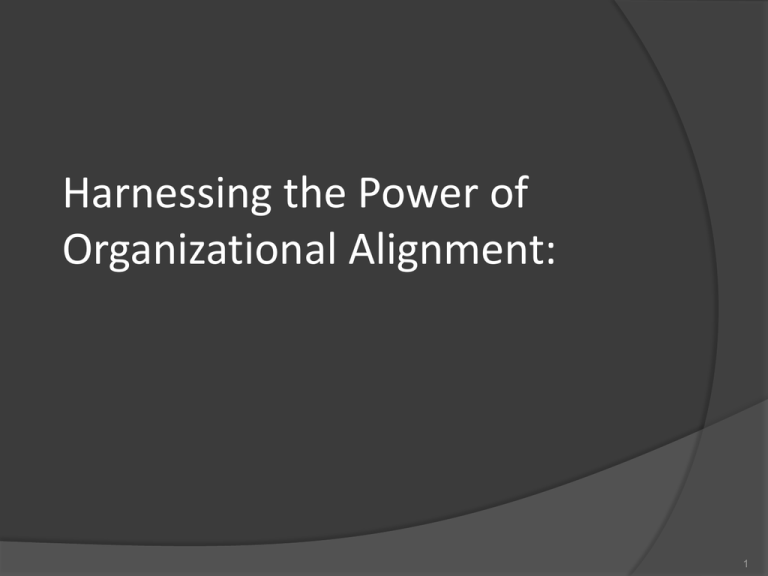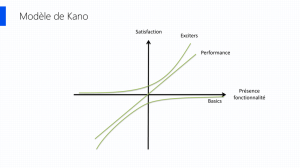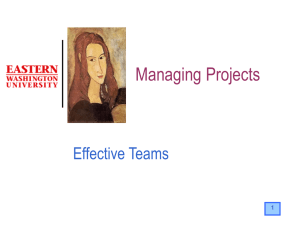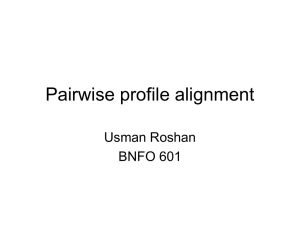Case study - Sales versus Services
advertisement

Harnessing the Power of Organizational Alignment: 1 Static Alignment 2 Dynamic Alignment 3 The Goal of Strategic Alignment A Seamless Culture of Shared Purpose “Well aligned companies outperform their competitors on every major financial measure.” “Alignment is the essence of management” George Labovitz and Harvard Business School Fred Smith, FedEx 4 The Reality 5 53% of people don’t feel their company strategy will lead to success … Booz 2011 6 80% of employees would leave if given the opportunity … The Economist, 2011 7 70% of the time the problem is not bad strategy but bad execution … Fortune, 2010 8 73% of workers don’t believe they are supporting company strategy … Duncan Group 2011 9 90% of companies do not implement their strategy effectively … Kaplan and Norton 10 85% of CEOs believe strategic changes are implemented poorly … Grolman Group 11 68% say organizational disconnects and silos are the most significant challenge … 2010 PMO 2.0 Trending Report 12 Contributions to Company Valuation Intangible assets are responsible for 70% of value Intangible Assets Leadership Culture Innovation Engagement Alignment Tangible Assets Ernst and Young, 2009 Employee engagement a pre-condition and result of correct alignment Engagement is the outcome of one’s personal • • • • • Satisfaction Commitment Pride Loyalty Sense of purpose • • • • Advocacy Initiative Persistence Energy Engagement and the Bottom line A 50% spread in observed performance Companies with high levels of People Engagement improved 19.2% Companies with low levels of People Engagement declined 32.7% Towers Watson 15 Engagement and the Bottom line Wealth Creation The EPS growth rate of organizations with engagement scores in the top quartile was 2.6 times greater than organizations with below average scores. Gallup (survey of 89 organizations) 16 Engagement and the Bottom line Safety Those with engagement scores in the bottom quartile averaged 62% more accidents. Gallup 17 Engagement and the Bottom line Productivity Engaged people are consistently more productive, profitable, safer, healthier, and 87% less likely to leave their employer. Corporate Leadership Council & Fleming & Apslund 18 But … Engaged teams are not enough. They must also be aligned to the goals of the entire organization. Aligned teams Know there’s a plan Understand the plan Agree with the plan Buy into the plan Energize the plan 19 Looking for Alignment - Key Questions 1. 2. 3. What is our strategy? What do you do? How does what you do support the strategy? If a majority of employees feel aligned, the company is aligned Common Symptoms of Poor Alignment • • • • • • • • • • • • High turnover Inability to articulate strategy Lack of accountability Information hoarding Poor teamwork Little upward information flow Fragmentation and duplication Inappropriate or misguided initiative Excessive focus on short-term results Team goals trump corporate strategy Institutional apologists ‘Vest and Rest’ syndrome Looking for Alignment The key questions • Is the strategy clear and well-communicated? • Is leadership aligned to deliver unambiguous direction? • Do the processes work efficiently, or are there built-in conflicts? • Do I have a clear understanding of customer needs? • How does alignment impact attrition, retention, profitability and sustainability? 22 The Main Thing The Main Thing is to keep the Main Thing the Main Thing Quantitative alignment analytics can help 23 The Main Thing Strategy • The Main Thing Process • Customer • • Connecting employee behavior to the mission and strategy Linking teams and processes to customer needs Reshaping strategy with real-time customer information Creating a culture where all four elements work seamlessly People 24 The Axes of Alignment Horizontal Alignment • Eliminating boundaries between company and customer • Understanding, creating, delivering and supporting customer needs • Value creation throughout supply chain • Clearly differentiated and synergistic functional responsibilities Strategy Process Customer People Vertical Alignment • The rapid and efficient deployment of business strategy throughout the organization • Employee engagement and strategic buyin through consistent communication • Two-way flow of information through empowered employees • Enabled by measurable and actionable metrics 25 Challenges of Horizontal Alignment • • • • • Customer requirements change Customer voice hard to interpret Customers speak in present tense Few employees have direct interaction Understanding the customer is rarely a collective responsibility 26 The Longitude Problem Scilly Islands Naval Disaster 1707 Harrison’s Marine Timekeeper 1731 Big 5 Questions on Customer Focus • • • • • What do our customers care about the most What opportunities do we have to delight How well are we satisfying them now What are the “best-of-the-best” competitors doing What do we do to make us “difficult to do business with?” Horizontally aligned companies use the voice of their customers as their beacon 28 The Self-Aligning Company • • • • • • Invisible hand of culture Adjustments made quickly at all levels Organization senses needs and changes Distributed leadership Disciplined enough to continually monitor the internal and external worlds Do the right things right and concentrate on key metrics only 29 Steps to Align an Organization Survey Analyze Diagnose Adjust 30 Powerful Alignment Analytics Summary Wheel Overall Alignment Index “The Main Thing” Category “Critical Success Factors” Dependent Factor “Key Indicators” Q1 Q2 Red – alert (1-55) Yellow – opportunity (56-79) Green – best practice (80-100) Q3 Survey Questions “The best business tool in America” Andy Greig, Division President, Bechtel Corp 31 Powerful Alignment Analytics Summary Wheel Comparative Alignment Dashboard Team 1 Team 2 Team 3 32 Powerful Alignment Analytics 33 Powerful Alignment Analytics 34 Value of Alignment Analysis • Develops long- and short-term action plans • Pinpoints areas requiring management attention • Launches improvement initiatives • Identifies skill gaps • Isolates best and worst practices • Distributes effective leadership • Aligns people, processes and strategies with market opportunities Strategy Process Customer People 35 Behaviour is complementary to personality Personality Situation Behaviour Performance Behavior Alignment Instrument from Behavioural Sciences Ltd Accelerating Sustaining Blocking Vision, change, increasing effectiveness, and driving things forward Consistency, efficiency, implementation, attention to detail and maintaining quality Responsibility avoidance, conflict avoidance, or anger and annoyance. Management behavior impacts alignment Return on Alignment The trademarked AlignComm methodology to aggregate, evaluate and prioritize remediation alternatives to determine which have the greatest impact on business results 38 AlignComm • • • • • • Strategic planning support and guidance Workshops and seminars Alignment and engagement surveys Executive coaching Behavioral Alignment diagnostics for managers Return on Alignment ® modeling for remediation prioritization • Messaging frameworks and collateral 39 40








